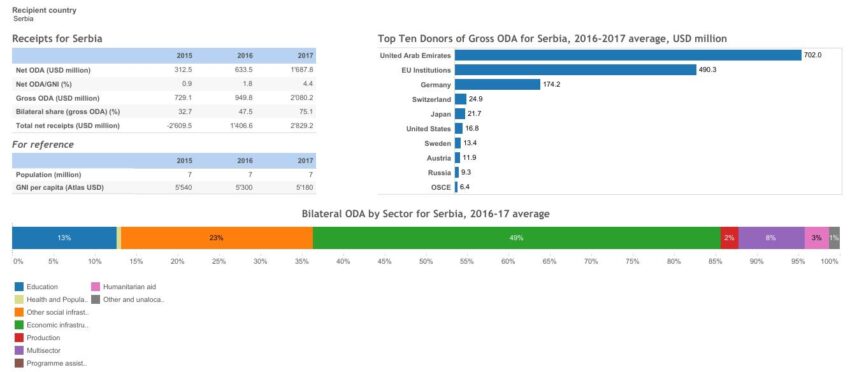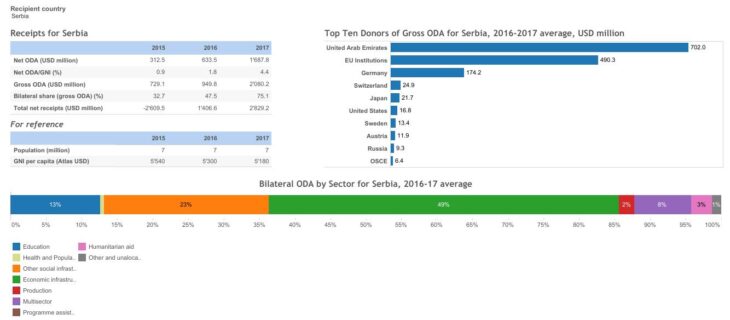Estimated GDP: US $ 53.0 billion (2019)
Per capita income (purchasing power parity): US $ 7,503 (2019)
Human Development Rank (HDI): Rank 63 (from 189 – 2019)
Proportion of poverty (less than $ 2 per day): 9.2% (2011)
Distribution of income (Gini coefficient): 34.0
Economic Transformation Index (BTI): Rank 27 (of 137) (2020)
Development goals, national development efforts
According to thereligionfaqs, the development goals of the national and international actors in Serbia are largely based on the UN Millennium Development Goals, and beyond that, within the framework of the EU integration process, on the level of development in the European Union.
The national development efforts of the individual government ministries have also been institutionally bundled since 2010 with the aim of achieving EU membership. In September 2010, for example, the Development Assistance Coordination Unit (DACU) was transferred from the responsibility of the Ministry of Finance to that of the SEIO, the Serbian European Integration Office, which coordinates the reforms required within the framework of EU integration. The DACU conducts the development policy dialogue with international partners and develops the national development plan NAD – Needs of the Republic of Serbia for International Assistance; its current version is from January 2014. This defines the sectoral priorities of development policy in the coming years in the areas of the rule of law, reform of public administrations, civil society, Competitiveness, human resources development, agriculture and rural areas, transportation, energy and environmental protection. Since the foundation of the Ministry for European Integration In 2017, with which the SEIO ceased its work, a department of the ministry took over the work of the DACU, the Department for Planning, Programming, Monitoring and Reporting on EU Funds and Development Assistance.
In the area of human resources development, which is closely based on the UN Millennium Development Goals, the eradication of poverty is a central priority. Serbia already had a poverty reduction strategy in 2002. The Serbian authorities had made considerable progress in the fight against poverty in the second half of the past decade, lifting 200,000 people out of poverty between 2006 and 2008. However, the subsequent economic crisis undermined these successes. At the end of 2010 the poverty rate was 9.2%, higher than before the crisis (2007: 8.3%). Poverty in Serbia is primarily a rural phenomenon and also affects socially disadvantaged groups disproportionately, including Roma. At the same time, the current system of social assistance has not been adapted to the needs of the most needy, so far only a small part of the transfer payments have reached you. With the support of the World Bank, the Serbian government has taken the first steps in recent years to reform the social assistance system.
Foreign development efforts
Foreign development efforts are undertaken through international and national organizations. The EU and other European institutions such as the ERBD and the EIB play a prominent role. The World Bank, the IMF, UNDP and the OSCE are also present on site.
In addition to Germany, the most important national donors with local development aid organizations are the USA (USAID, NDI), Norway, Sweden (SIDA), Italy, Austria, Switzerland (DEZA), Spain and Japan. In recent years there has been a significant decrease in bilateral funding in favor of EU funding, for example Great Britain closed its development aid office in Serbia in 2011. In the EU integration process, EU aid is provided through the Pre-Accession-Fund IPA, through which Serbia receives an average of 200 million euros annually. So far, there has been a lack of strategic use of the funds made available.
German development cooperation
With around 1.5 billion euros in aid pledges since the democratic regime change in 2000, Germany is the second largest donor after the USA; Of this, almost 1 billion euros flowed bilaterally, the rest through the EU. In 2017, bilateral development cooperation totaled 189.9 million euros.
Focus: The focus of German development cooperation in recent years has been on economic development, improving economic framework conditions – from good governance, ecological modernization of the energy sector (ecological modernization and increasing energy efficiency, district heating projects – KfW) and the water sector (modernization of drinking water and sewage systems), strengthening local government and local self-government (promoting fiscal decentralization, local economic development, land management) and finally promoting tourism. In addition, measures in the youth sector were promoted. All of these measures contribute to the country’s EU integration and are part of this development framework. In addition, since 2014 the federal government has provided the Serbian government with two German advisors, one for economic policy issues and another for combating corruption.
Development cooperation organizations in Serbia: The German organizations active in development cooperation with offices on site are GIZ and KfW. In addition, the Center for International Migration and Development (CIM) places integrated experts in Serbia. In addition, all German political foundations are represented with offices in Serbia, the Konrad-Adenauer-Stiftung, the Friedrich-Ebert-Stiftung, the Heinrich-Böll-Stiftung, the Hans-Seidel-Stiftung and the Rosa-Luxemburg-Stiftung with Landes- resp Regional offices, as well as the Friedrich Naumann Foundation with a project office.

